Research Updates
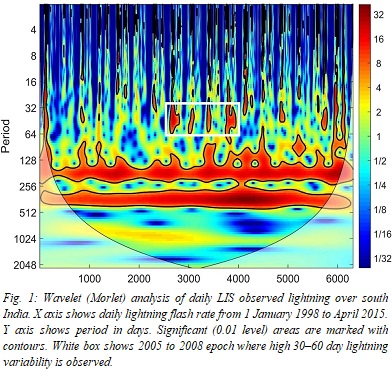 Lightning characteristics in India are examined with satellite-based Lightning Imaging Sensor (LIS) and ground-based Indian Lightning Detection Network (ILDN). LIS observations indicated that synoptic weather systems are major contributors of lightning in Indian hotspots. Western disturbances (mid-tropospheric systems with extratropical origin) were the greatest contributor of lightning in the Himalayas (93%), tropical cyclonic storms and low-pressure systems (oceanic in origin) were key lightning contributors in parts of eastern India (43%), and lower tropospheric troughs were major contributors in other hotspots. For the first time, this study reported the occurrence of significantly high lightning activity before active monsoon spells in the Central India region (65–87° E, 18–27° N). Consequently, satellite-based lightning observations could be used to predict active monsoon spells. Harmonic analysis was used to study diurnal lightning-flash density. The maximum observed standardized diurnal amplitude of lightning activity was 0.35, and maximum explained diurnal variation was 15%. Also, for the first time, we compared the ILDN data and LIS observations, and found good agreement regarding lightning variability. LIS data showed an increase in annual lightning activity in tropical South-western India (SWI), and the results also suggested that during El Niño and negative Indian Ocean Dipole periods, SWI experiences above-average lightning activity.
Lightning characteristics in India are examined with satellite-based Lightning Imaging Sensor (LIS) and ground-based Indian Lightning Detection Network (ILDN). LIS observations indicated that synoptic weather systems are major contributors of lightning in Indian hotspots. Western disturbances (mid-tropospheric systems with extratropical origin) were the greatest contributor of lightning in the Himalayas (93%), tropical cyclonic storms and low-pressure systems (oceanic in origin) were key lightning contributors in parts of eastern India (43%), and lower tropospheric troughs were major contributors in other hotspots. For the first time, this study reported the occurrence of significantly high lightning activity before active monsoon spells in the Central India region (65–87° E, 18–27° N). Consequently, satellite-based lightning observations could be used to predict active monsoon spells. Harmonic analysis was used to study diurnal lightning-flash density. The maximum observed standardized diurnal amplitude of lightning activity was 0.35, and maximum explained diurnal variation was 15%. Also, for the first time, we compared the ILDN data and LIS observations, and found good agreement regarding lightning variability. LIS data showed an increase in annual lightning activity in tropical South-western India (SWI), and the results also suggested that during El Niño and negative Indian Ocean Dipole periods, SWI experiences above-average lightning activity.
Bibliographic Info: Unnikrishnan, C. K., Sunil Pawar, Gopalakrishnan, V. [2021]. Satellite-observed lightning hotspots in India and lightning variability over tropical South India. Advances in Space Research, Vol. 68 (4), pp. 1690-1705. https://doi.org/10.1016/j.asr.2021.04.009
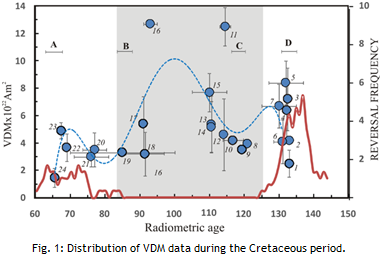 Knowledge about long-term variation of the geomagnetic dipole field remains in its nascent stage because of the paucity of reliable experimental data over geological periods. Here, we present the first robust experimental data from the largest Cretaceous flood basalt province on Earth, the ~65–66 Ma Deccan basalt within a thick (1250 m) unbiased stratigraphic section down to the basement, recovered from a drill hole of the Koyna Deep Scientific Drilling Project in the Western Ghats, India. Critical analysis of the result along with similar results of the Cretaceous age find that (i) the dipole moment during the end Cretaceous Deccan eruption is the lowest in whole of Cretaceous (ii) dipole moment at the onset/termination of the Cretaceous Normal Superchron is apparently lower relative to that in mid-superchron, however, such differences cannot be deciphered in shorter polarities probably because of insufficient time to develop recognizable variations (iii) inverse relation between dipole moment and reversal rate is lacking and (iv) a cause and effect relation between core-mantle boundary heat flux and low dipole moment that appears to be the principle governing factor in forming the Large Igneous Provinces on the surface of earth.
Knowledge about long-term variation of the geomagnetic dipole field remains in its nascent stage because of the paucity of reliable experimental data over geological periods. Here, we present the first robust experimental data from the largest Cretaceous flood basalt province on Earth, the ~65–66 Ma Deccan basalt within a thick (1250 m) unbiased stratigraphic section down to the basement, recovered from a drill hole of the Koyna Deep Scientific Drilling Project in the Western Ghats, India. Critical analysis of the result along with similar results of the Cretaceous age find that (i) the dipole moment during the end Cretaceous Deccan eruption is the lowest in whole of Cretaceous (ii) dipole moment at the onset/termination of the Cretaceous Normal Superchron is apparently lower relative to that in mid-superchron, however, such differences cannot be deciphered in shorter polarities probably because of insufficient time to develop recognizable variations (iii) inverse relation between dipole moment and reversal rate is lacking and (iv) a cause and effect relation between core-mantle boundary heat flux and low dipole moment that appears to be the principle governing factor in forming the Large Igneous Provinces on the surface of earth.
Bibliographic Info: Radhakrishna, T., Asanulla R. Mohamed, Venkateshwarlu, M., Soumya, G. S. [2020]. Low geomagnetic field strength during End-Cretaceous Deccan volcanism and whole mantle convection. Scientific Reports, Vol. 10 (1), Art. 10743. https://doi.org/10.1038/s41598-020-67245-6
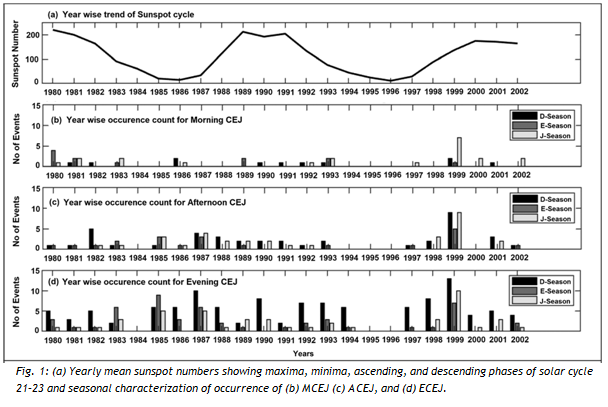
The quiet time characteristics of equatorial electrojet (EEJ), counter electrojet (CEJ), and solar quiet (Sq) day geomagnetic field over two decades (1980–2002) are established using Principal component analysis (PCA) from equatorial (Ettaiyapuram) and off‐equatorial (Hyderabad) Magnetic Observatories, India, over sunspot cycles 21–23. The patterns of normal field shows that the diurnal amplitudes were strong during equinox compared to other seasons. Varying contributions of abnormal field in different Lloyd's seasons were evident in different phases of sunspot cycle. The diurnal amplitudes have reduced from the 21st to the 23rd sunspot maxima following the trend of weakening of sunspot cycle. Analysis of seasonal means shows evening CEJs were more pronounced when compared to morning and afternoon in different phases of sunspot cycle. The abnormal field variations have a strong correlation with the occurrence of afternoon CEJs during solar minima; a correlation of seasonal occurrences of CEJs with phases of sunspot cycles is revealed.
Bibliographic Info: Chandrasekhar, N. P., Arka Roy [2020]. Imprints of sunspot cycles on normal and abnormal geomagnetic fields: Case study from equatorial and low‐latitude sites of India. Journal of Geophysical Research: Space Physics, Vol. 125 (12), Art. e2020JA028464. https://doi.org/10.1029/2020JA028464
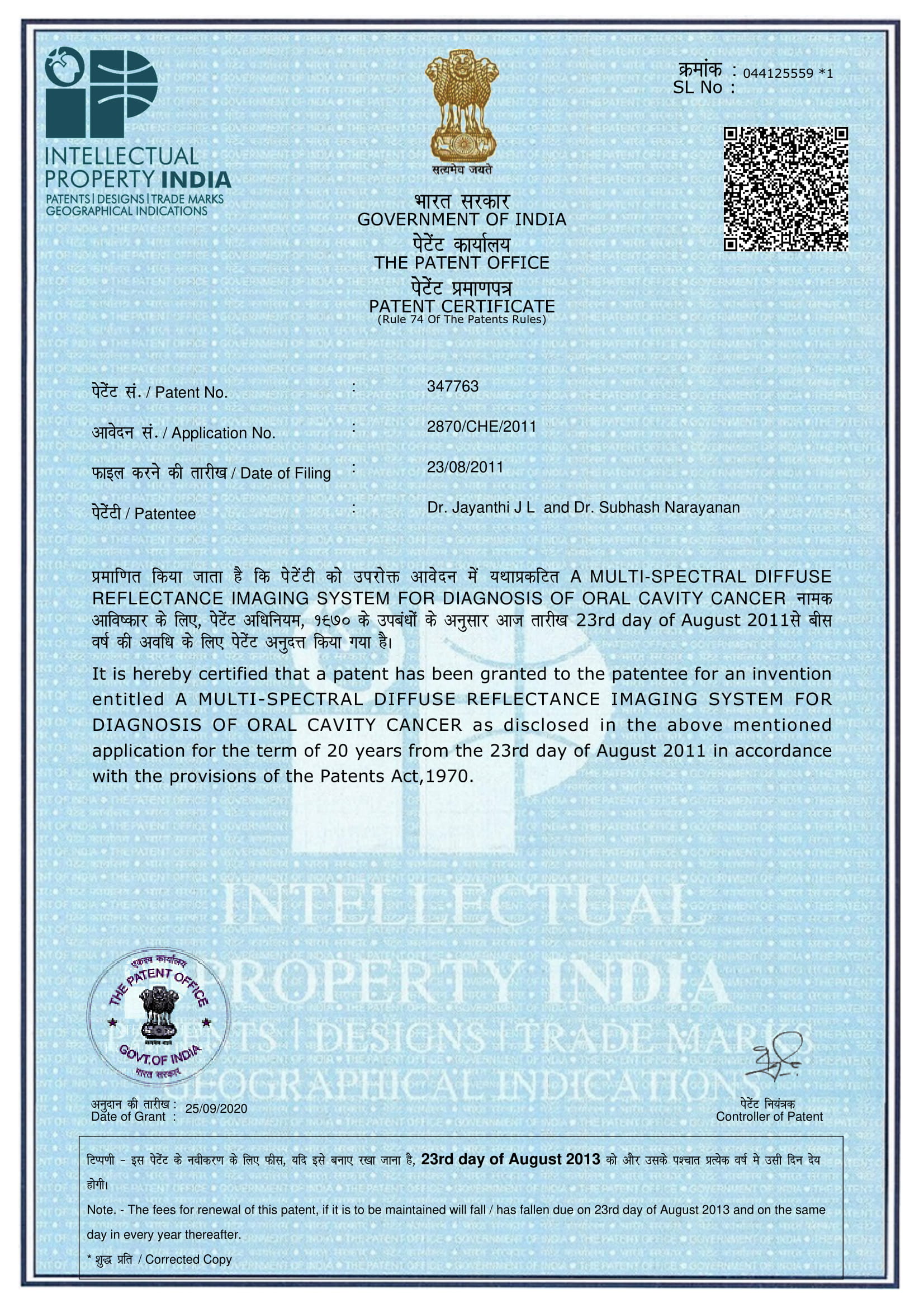 A patent was granted for an invention entitled ‘A multi-spectral diffuse reflectance imaging system for diagnosis of oral cavity cancer’
A patent was granted for an invention entitled ‘A multi-spectral diffuse reflectance imaging system for diagnosis of oral cavity cancer’
Patentee Info: Dr. J. L. Jayanthi, Dr. Subhash Narayanan
National Centre for Earth Science Studies.
Intellectual Property India, Patent No. 347763 dated 25/09/2020.
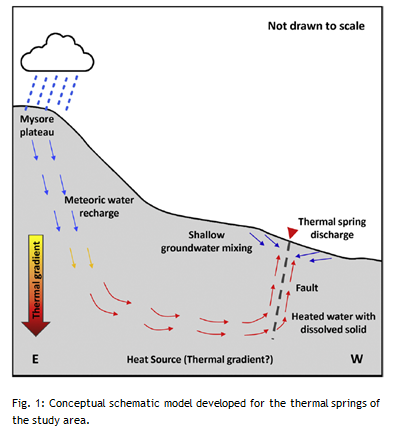 The west coast of India is one of the important geothermal provinces that hosts many thermal springs of varying discharge characteristics. A total of twenty thermal springs have been reported in this region falling into two different suites of geological formations. Two low temperature geothermal springs located in the south Konkan region were studied with the objectives (1) to understand the geochemical evolution, (2) to identify the recharge source and (3) to propose a reservoir temperature. The hydrogeological and geochemical investigations were carried out on two geothermal springs, viz. Bandaru and Irde, both located in the Dakshina Kannada district of the Karnataka state, India. In this region, low-temperature geothermal activity has been reported in the form of the evolution of warm water from thermal spring systems with a notable presence of faults/lineaments in the geological formation. These faults enable the upward flow of geothermally heated water. The hydrochemistry of water samples was analyzed to determine the dominant hydrogeochemical processes in the region. These thermal springs are categorised as Na-HCO3 type facies. The thermal water is of a moderately alkaline nature like other geothermal springs of the west coast of India. Based on the results for major and trace element concentrations it was found that the hydrochemical process was mainly controlled by the dissolution of silicate minerals with a marginal influence from anthropogenic activity. Evaluation of δD and δ18O stable isotope data suggested that the thermal springs and adjacent surface and groundwater were of meteoric origin. Reservoir temperature was estimated with Na-K-Ca, K2/Mg, quartz and chalcedony geothermometers. The results suggest that the reservoir under consideration is a low enthalpy reservoir with temperatures ranging between 55 and 86 °C.
The west coast of India is one of the important geothermal provinces that hosts many thermal springs of varying discharge characteristics. A total of twenty thermal springs have been reported in this region falling into two different suites of geological formations. Two low temperature geothermal springs located in the south Konkan region were studied with the objectives (1) to understand the geochemical evolution, (2) to identify the recharge source and (3) to propose a reservoir temperature. The hydrogeological and geochemical investigations were carried out on two geothermal springs, viz. Bandaru and Irde, both located in the Dakshina Kannada district of the Karnataka state, India. In this region, low-temperature geothermal activity has been reported in the form of the evolution of warm water from thermal spring systems with a notable presence of faults/lineaments in the geological formation. These faults enable the upward flow of geothermally heated water. The hydrochemistry of water samples was analyzed to determine the dominant hydrogeochemical processes in the region. These thermal springs are categorised as Na-HCO3 type facies. The thermal water is of a moderately alkaline nature like other geothermal springs of the west coast of India. Based on the results for major and trace element concentrations it was found that the hydrochemical process was mainly controlled by the dissolution of silicate minerals with a marginal influence from anthropogenic activity. Evaluation of δD and δ18O stable isotope data suggested that the thermal springs and adjacent surface and groundwater were of meteoric origin. Reservoir temperature was estimated with Na-K-Ca, K2/Mg, quartz and chalcedony geothermometers. The results suggest that the reservoir under consideration is a low enthalpy reservoir with temperatures ranging between 55 and 86 °C.
Bibliographic Info: Prasenjit Das, Maya, K., Padmalal, D. [2020]. Hydrochemistry, geothermometry and origin of the low temperature thermal springs of South Konkan region, India. Geothermics, Vol. 90, Art. 101997. https://doi.org/10.1016/j.geothermics.2020.101997




 RTI Act
RTI Act
